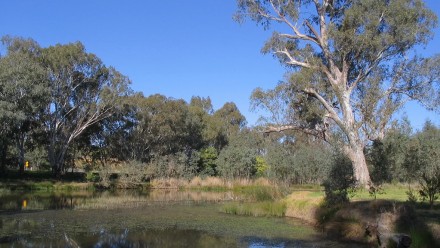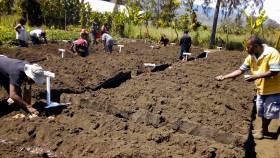Developing Nature-Based Solutions for Flood Resilience
The Problem: Traditional engineering approaches to flood risk management (dams or levees) can be successful, but they are not keeping pace with escalating flood risks fueled by climate change.
We Are: A team of researchers (drawn from the fields of hydrology, social science, ecology and economics) who are partnering with communities to develop the first ever Australian guidelines on Nature-based Solutions for flood mitigation and resilience.
Flooding is expected to cause increasing loss and damage in regional communities situated on floodplains as levees and dams are over-topped by ever greater floods. Flooding however is a natural process essential for floodplain ecosystems.
Dams, levees and other engineering approaches to flood protection and water management can often cut across floodplains, separating them from river channels and constraining natural flows. This can degrade riverine and floodplain ecosystems, their functions and biodiversity and can increase the risk of extreme flooding.
Communities can also be disadvantaged by the loss of recreation and tourism opportunities and impacts on critical groundwater recharge.
Unlike traditional engineering solutions, Nature-based Solutions can increase the natural resilience of the landscape, allowing the natural environment to function with reduced impact on surrounding communities.
Our aims in developing Australian Guidelines for Nature-based Solutions (NbS) are to:
- improve flood resilience using NbS for flood risk management
- quantify the impacts on flooding and the benefits of NbS
- build capacity for local government and community decision-making
- demonstrate how researchers, community groups, and government at all levels can
So what are Nature-based Solutions to Flooding?
NbS for flood mitigation are approaches that aim to protect, sustainably manage, and restore ecosystems to meet critical societal needs today while building long-term environmental and economic resilience.
Currently, there is a lack of knowledge on how to best incorporate NbS to increase flood resilience in Australian communities. Generally, it is recognised that NbS can:
- Slow floods and help keep them away from populated areas
- Reduce the energy and extent of the flood by reducing flood flows or inundated areas, and
- Divert flood flows to reduce inundation areas in target locations
For example: wetlands may store overflows during a flood event and/or reduce flood impacts by modifying the flood hydrograph, delaying and reducing the flood peak. Afforestation can reduce runoff during a flood event. Urban solutions such as permeable pavements and urban gardens can assist in increasing ground surface infiltration. Paleochannels/ paleo-valleys can divert flood flows from target locations.
This initiative - funded by the Australian Government National Emergency Management Agency - is engaging ten regional partners across NSW, Queensland and Victoria to identify and evaluate NbS to increase flood resilience and to integrate NbS into flood risk management plans.
Our Core Team
- Associate Professor Roslyn Prinsley, Head of Disaster Solutions
- Liam Taylor, Program Officer, Disaster Solutions
- Carolyn Lambert, Project Officer, Nature-based Solutions
- Dr Mahdi Sedighkia, Chief Modeller and Senior Research Fellow, Hydraulic and Hydrodynamic Modelling, Nature-based Solutions
- Dr Susan Hunt, Senior Research Fellow, Social and Institutional, Nature-based Solutions
- Prabhasri Herath, Postdoctoral Research Fellow, Nature-based Solutions
- Karen Jackson, Community Engagement, Nature-based Solutions
- Tony Webster, Visiting Fellow - Economics, Nature-based Solutions
- Katie Menzies, Senior Research Officer - Ecology, Nature-based Solutions
- Laura Chen, Research Officer - Economics, Nature-based Solutions
- Associate Professor Barry Croke, Research Team, Nature-based Solutions (ANU Mathematical Sciences Institute and Fenner School for Environment and Society)
- Dr Jeremy Smith, Research Team, Nature-based Solutions (ANU School of Engineering)
- Dr Hayley Henderson, Research Fellow, (Institute for Infrastructure in Society, Crawford School of Public Policy)











